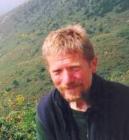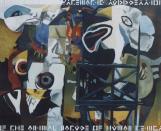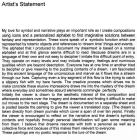1
Jurgen Mohr, one of five children, was born in 1948 in Theisenort, Germany, as Jürgen Klaus Mohr. He was raised in Germany until 1956, and in southern Ontario thereafter, when his family moved to Canada.In 1969, he moved to Toronto, Ontario, where he studied fine arts at York University from 1969 to 1970. In 1970, he moved to Guelph, Ontario, where he studied fine arts, history, sculpture and printmaking with John Fillion and Walter Bachinski at Guelph University from 1970 to 1972 and earned a degree in fine arts.
In 1972, he moved to Owen Sound, Ontario, where he worked as administrator of the Grey Bruce Art and Craft Centre. In 1974, he moved to Chatham, Ontario, where he worked as a teacher of sculpture and art history at St. Clair College from 1974 to 1976. In 1976, he moved to North Bay, Ontario, and taught art and graphic communications at Canadore College until 1980. From 1980 to 1991, he worked as a graphic designer for the Forest Products Accident Prevention Association and from 1991 to 1993, he worked as a freelance graphic designer for Penney Advertising & Design Co. From 1993 to 1995, he worked as a silkscreen technician for Mad Rat Promo Wear.
He has been working as a full-time artist since 1994.
In 1994, he married Luisa Valerio. He has two children from a former marriage.
He served on the board of directors of White Water Gallery in North Bay in 1986 and again in 2006.
Solo exhibitions of his work have been held at: Joan Ferneyhough Gallery, North Bay, Ontario (2004, 2002, 2000, 1998, 1996), White Water Gallery (2001, 1989), W. K. P. Kennedy Gallery, North Bay, Ontario (1996, 1988), and Thames Arts Centre, Chatham, Ontario (1976).
He received a Materials Assistance Grant from the Ontario Arts Council in 2001, 1998, 1996, 1987, 1986, and 1976.
Jurgen's works are in private, public and corporate collections, including the Champlain Park (North Bay), North Bay City Hall Ontario Trapper's Association, Redpath Collection, Waterloo Separate School Board, and the W. K. P. Kennedy Gallery. A bronze relief by Jurgen has been permanently installed in North Bay since 1985.
Jurgen Mohr is represented by Joan Ferneyhough Gallery in North Bay.
(The biographical information featured here was written in consultation with the artist in 2006.)
Interview:
The high school Jurgen Mohr attended had wonderful art on its walls, but it didn't have an art program, so he and three students banded together to work on projects without any instruction behind the school stage, using the materials available to them-whether it be ice for an ice sculpture, or a box of pastels donated by a teacher.
He first truly "felt the calling" to become an artist in the early 90s, when he set up a log cabin on a native reserve, which he intended to be a studio space. He felt, "I'm going to do this and sacrifice everything." Although the logistics of living without an income in a remote area was challenging, the commitment to art making was significant.
When asked if there is any influence of the northern environment on his work, Jurgen says, "There was a time I would have denied there's a connection," in part because his work is internal. However, he feels that there is a closeness to nature in North Bay, where he now lives. "There's an energy here," where he feels connected to something deeper and mysterious. It's a raw energy, he says, and it allows artists to slow down and connect with their work.
Plus, he says, "As long as there's a plane to Europe or a bus to Toronto I don't feel too distant from the major centres."
Connecting with his artistic practice is very important. Jurgen keeps a dream journal, in which he writes for approximately an hour per day. "It's a discipline," he says, in the truest sense of the word. When talking about the importance of having an open subconscious state, he talks about a veil that can be pulled back by certain objects or events.
The original material generated in the journal means he doesn't base his work on other artists' work. He clarifies that not all entries become part of an art piece, but that "little pearls come through." Rarely does a finished piece appear in his imagination; for the most part, his work is an "evolving process."
(By Heather Saunders, based on an interview in December, 2006).



